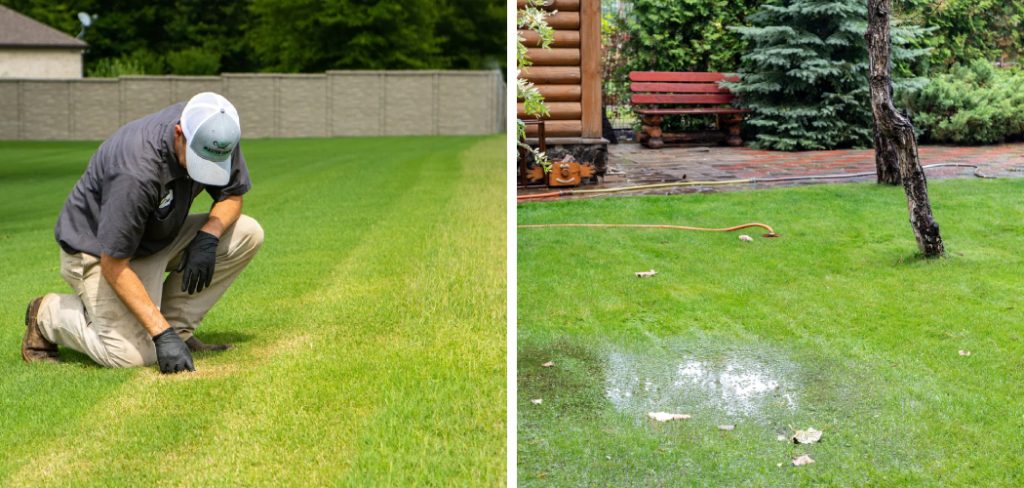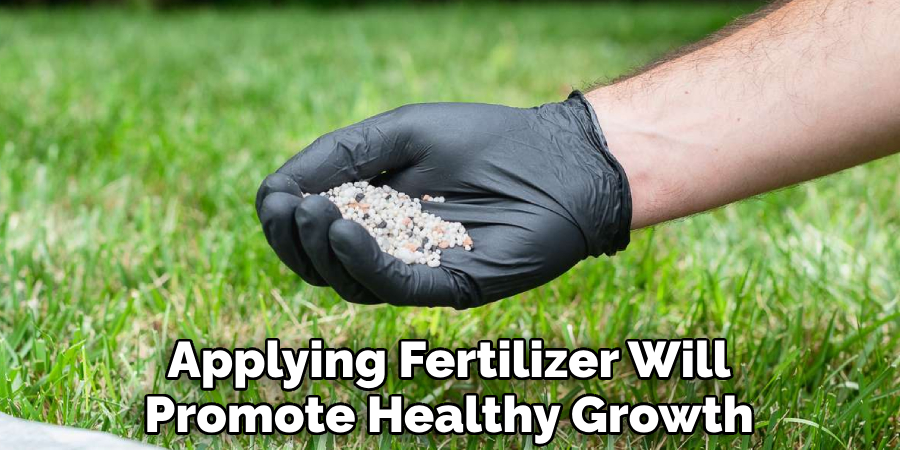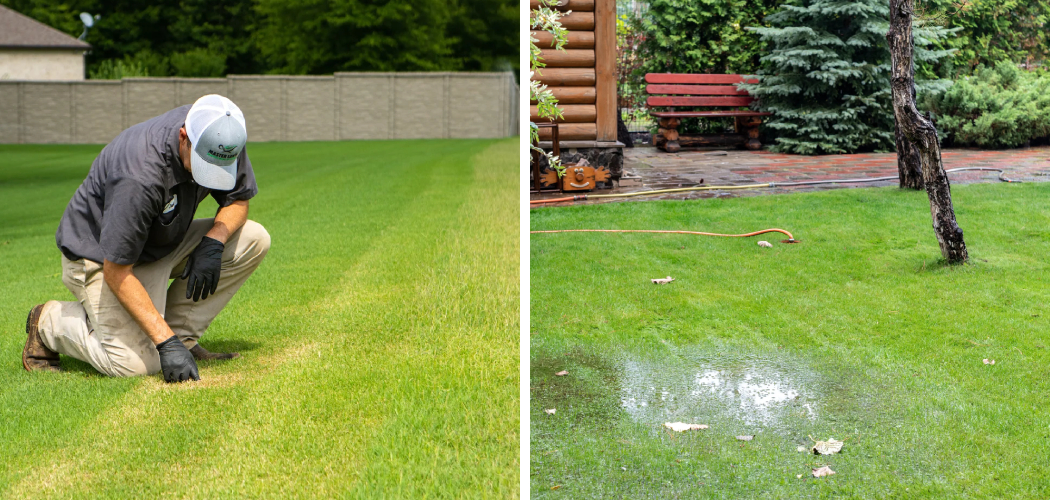If you find yourself with an overwatered lawn, don’t worry! There are steps you can take to fix it. how to fix overwatered lawn involves making a few adjustments.
Firstly, adjust your irrigation schedule by watering deeply but infrequently. This allows the soil to dry out between waterings and encourages deep root growth. Secondly, ensure proper drainage by aerating the lawn, which helps water penetrate the soil effectively. Lastly, improve water absorption by amending the soil with organic matter, such as compost. This helps the soil retain moisture without becoming waterlogged. By following these steps, you can effectively fix an overwatered lawn and restore it to a healthy and vibrant state.
This will help prevent soil saturation and promote healthy root development. Aerate the lawn by using a garden fork or aerator machine, creating small holes in the soil to promote air circulation and water infiltration. Applying a suitable fertilizer will also aid in the recovery process, providing necessary nutrients for the grass to thrive.
Regularly monitor the lawn’s moisture levels and adjust your watering frequency accordingly, keeping in mind factors such as rainfall and season.

Reasons For Overwatered Lawns
Overwatering your lawn can cause significant damage to its health and appearance. Many common mistakes lead to this problem. One of the main reasons for overwatered lawns is a lack of knowledge about proper watering techniques. People often water their lawns excessively due to fear of under-watering.
However, excessive water can suffocate the grass roots and promote the growth of weeds and diseases. Additionally, complicated irrigation systems or inconsistent watering schedules can also contribute to overwatering. The effects of excessive water on lawns are not only limited to the aesthetic appeal but also impact the overall health of the grass.
Overwatered lawns may become more susceptible to diseases, pests, and fungal infections. Moreover, they tend to have shallow root systems, leading to increased vulnerability during droughts. It is crucial to understand the negative effects of overwatering and adopt proper watering practices to maintain a healthy and vibrant lawn.
Signs Of An Overwatered Lawn
An overwatered lawn can be problematic, but there are signs that can help you identify the issue. If your grass is yellowing or wilting, it may be a result of too much water. Another indication is a mushy or spongy feel underfoot when you walk on the lawn.
This can be a sign of excessive moisture in the soil. Additionally, if you notice any fungus or mold on the grass, it could be due to overwatering. To fix an overwatered lawn, you should adjust your watering schedule accordingly, allowing the soil to dry out before the next watering.
Additionally, ensuring proper drainage and managing any existing fungus or mold will help restore the health of your lawn. Take the time to monitor the signs and take appropriate action to keep your lawn thriving.
How to Fix Overwatered Lawn: 7 Essential Tips
1. Assess The Damage
Assess the damage by determining the extent of overwatering. Check soil moisture levels regularly to identify the problem. Evaluate the condition of the lawn, looking for signs of overhydration such as standing water or mushy soil. Examine the grass blades for discoloration, wilting, or sponginess.
Observe if the lawn is growing unevenly or if there are issues with drainage. Additionally, keep an eye out for the presence of weeds or pests, as overwatering can create favorable conditions for their growth. Moreover, consider the climate and weather patterns to understand how they may have contributed to the overwatering.
Properly assessing the damage will provide valuable insights to help you formulate an effective plan for fixing an overwatered lawn.
2. Adjust Watering Schedule
To fix an overwatered lawn, adjusting your watering schedule is crucial. First, reduce both the frequency and duration of watering sessions. This means giving your lawn less water and allowing the soil to dry out a bit between watering. To accurately gauge the amount of rain your lawn receives, use a rain gauge.
A moisture meter can also help you determine the soil’s moisture content, preventing overwatering. By following these simple steps, you can gradually restore your lawn’s health and prevent future overwatering issues. Remember, a balanced watering schedule is essential for maintaining a lush, green lawn.
3. Improve Drainage
Properly maintaining a lawn includes ensuring that the right amount of water reaches the grass. Overwatering can lead to poor drainage, which in turn affects the health of your lawn. To improve drainage, one effective method is aerating the lawn.
By creating small holes in the soil, aerating allows water to penetrate deeper and prevents excessive pooling on the surface. Another way to optimize drainage is by adding organic matter to the soil. This improves the structure and texture, resulting in better water flow and absorption.
By following these techniques and addressing the issue of overwatering, you can prevent waterlogged lawns and promote a healthier and more vibrant outdoor space.
4. Adjust Mowing Practices
Proper lawn mowing techniques are crucial in fixing an overwatered lawn. Adjust your mowing practices by raising the mower blade height. This will help prevent further damage to the overwatered grass. By cutting the grass at a higher level, you allow the roots to grow deeper and become more resilient.
Additionally, this technique helps in reducing water evaporation from the soil. It is important to practice regular mowing to keep the grass at an optimum height. This will promote a healthier lawn and prevent the growth of weeds. Remember to avoid cutting more than one-third of the grass blade length at a time.
Proper mowing combined with other lawn care techniques will gradually revive your overwatered lawn into a lush and vibrant landscape. Keep these tips in mind for a well-maintained lawn throughout the year.
5. Overseed And Fertilize
To fix an overwatered lawn, start by overseeding the affected areas with the right grass seed suited for your region. This will help fill in the bare spots and restore the lawn’s lushness. Additionally, applying fertilizer will promote healthy growth, providing the necessary nutrients for the grass to thrive.
Make sure to choose a fertilizer that meets the specific needs of your lawn and follow the recommended application instructions. Taking these steps will help revive your overwatered lawn and bring it back to its former glory. Remember, proper watering practices are essential to prevent future overwatering and maintain a healthy lawn.
Keep an eye on the weather conditions and adjust your watering schedule accordingly to avoid further damage.
6. Monitor And Adjust Maintenance Practices
Regularly monitor soil moisture levels to ensure your lawn is not overwatered. Adjust watering and mowing practices based on these readings. By staying vigilant and aware of your lawn’s water needs, you can prevent overwatering and the damage it causes.
Pay attention to signs of excessive moisture, such as a spongy feel underfoot or a persistently wet surface. If you notice these signs, scale back your watering and allow the soil to dry out slightly before watering again. Similarly, adjust your mowing schedule to ensure you’re not cutting the grass too short, as this can contribute to moisture loss.
By implementing these practices, you can maintain a healthy, vibrant lawn without the risk of overwatering.
7. Seek Professional Help If Necessary
If your lawn is suffering from overwatering, it may require professional assistance. Seeking the advice of a lawn care expert is crucial, especially for severe cases. Consulting with a professional will ensure that you receive the right guidance and solutions for your specific lawn care needs.

They can assess the damage caused by overwatering and suggest appropriate remedies. Remember to follow their instructions carefully to restore your lawn’s health. By getting expert help, you can save time, effort, and potentially avoid further damage. So, if you’re dealing with an overwatered lawn, don’t hesitate to seek the expertise of a professional.
They will provide you with the right guidance to fix the issue and maintain a healthy lawn.
Frequently Asked Questions On How To Fix Overwatered Lawn
How Do I Know If My Lawn Is Overwatered?
To determine if your lawn is overwatered, look for signs such as standing water, spongy or squishy grass, mold or fungus growth, and a lack of new growth. Overwatering can lead to root rot and other issues if not addressed promptly.
How Often Should I Water My Lawn?
The frequency of watering depends on various factors like soil type, climate, and grass species. As a general guideline, it’s recommended to water deeply but infrequently, about 1 to 1. 5 inches per week. Use a rain gauge or moisture meter to help gauge when to water.
What Are The Consequences Of Overwatering A Lawn?
Overwatering a lawn can have detrimental effects such as nutrient leaching, shallow root growth, increased weed growth, and susceptibility to diseases. It can also lead to the wastage of water and higher water bills. Proper watering practices are crucial for maintaining a healthy lawn.
How Can I Fix An Overwatered Lawn?
To fix an overwatered lawn, start by adjusting your watering schedule to prevent further overwatering. Allow the soil to dry out between watering sessions. Aerate the lawn to improve drainage, and apply a balanced fertilizer to promote healthy root growth.
Consider reducing shade to minimize water retention.
Can An Overwatered Lawn Be Saved?
In most cases, an overwatered lawn can be saved by taking corrective measures promptly. Adjust the watering schedule, improve drainage, and provide proper aeration to help the lawn recover. However, if the damage is severe and the roots are extensively affected, it might be necessary to reseed or replant the lawn.
Conclusion
Taking immediate action is crucial when dealing with an overwatered lawn. By following the right steps, you can restore the health and vigor of your once-lush grass. Begin by identifying the signs of overwatering, such as pooling water or spongy soil.
Adjust your watering schedule accordingly, making sure to water deeply but infrequently. Consider implementing proper drainage techniques, such as grading or installing a french drain, to prevent future overwatering issues. Additionally, mindful mowing practices can help your lawn recover faster.
Avoid cutting the grass too short and ensure your mower blades are sharp. Lastly, nourish your lawn with the right balance of nutrients by applying a suitable fertilizer. By implementing these tips and closely monitoring your lawn’s moisture levels, you can have a healthy, vibrant lawn that will be the envy of the neighborhood.

